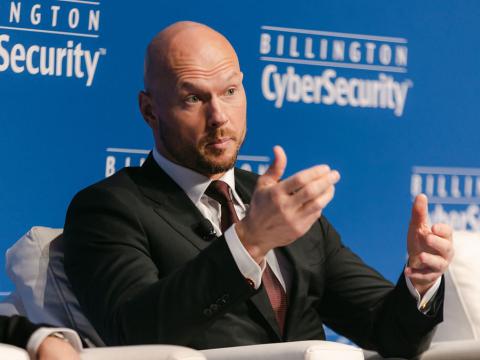Utility Approach Emerges From Communications Access Strategy
Telecommunications giant builds network to integrate voice, data and video capabilities.
The solution for providing bandwidth on demand may be for telecommunications providers to imitate electric companies. Treating bandwidth as a utility is an approach that one major telecommunications provider believes could be the communications wave of the future. By ordering bandwidth as needed via a new communications system, users could extend or cut back their capabilities and pay only for what they use. For the military, which often needs to increase capabilities during an exercise, the technology allows this increase in use without installation of additional or bigger lines that could stand unused most of the time.
This new way of offering telecommunications services would benefit both business and residential customers by eliminating the need for multiple telephone lines in homes or by decreasing the need for separate networks to handle voice, data and video communications at businesses. Users could facilitate their communications capabilities without overbuilding their architecture, the system’s developers say.
Known as Sprint ION, for integrated on-demand network, this technology is being offered to large businesses now and will be introduced to consumer markets at the end of this year. The technology is a combination of hardware and software that is part of a “confidential” $2 billion network and electronics upgrade that has taken place over the last five years at Sprint, Kansas City, Missouri, ION’s creator. In the next two years, company officials estimate that approximately $400 million more will be spent to further enhance networks and to build the necessary hubs for the system. These upgrades, Sprint representatives claim, are part of the company’s evolution of communications offerings.
The ION concept involves a seamless service offered over an asynchronous transfer mode (ATM) backbone network. Through this system, hardware and software are used to transmit information over a single network, integrating voice, data and video demands and offering high-speed, high-bandwidth communications access.
Sprint’s broadband data network is a cell-based architecture that supports voice and data communications. The user maintains a single connection to send communications through an integrated service hub (ISH) that is installed on site at a business or residence. The hub converts all protocols into one string. This stream of data leaves an installation and goes to a second hub. At the second hub, the information is translated and sent to its destination. If the information is not going to another hub on the ION network, a Sprint node will translate the information and send it to its destination outside the network.
The ISH partitions bandwidth to accommodate telephone, facsimile and Internet use, protecting voice capabilities at all times. A user can make 10 telephone calls at one time or use the bandwidth to make three telephone calls and send an image over the Internet. Sprint meters what goes through the hub to gather billing information.
Information travels from hubs across Sprint’s long-distance network that spans the United States. This network is being expanded through broadband metropolitan area networks, or BMANs. These BMANs are high-bandwidth fiber optic rings that encircle cities. By the end of 1999, the company plans to offer ION in 60 major markets that will include cities such as Chicago, Atlanta, Dallas, Houston, Kansas City, New York and Denver. In these cities, Sprint is working with the local telecommunications companies Southwestern Bell, BellSouth, Ameritech and GTE to ensure access to existing BMANs.
Sprint maintains that the ION service will pass within range of 70 percent of the nation’s large businesses through the metropolitan fiber optic/synchronous optical network (SONET) ring network. Small businesses and home users can access BMANs through broadband access services such as a digital subscriber line.
Offering a protective measure, fibers in the SONET ring network run in each direction. If a fiber is cut, information can still travel on the ring in the other direction, resulting in a loss of connectivity only at the break.
Sprint is partnering with Cisco Systems, Bellcore and RadioShack on the ION project. Cisco Systems is providing the hardware for voice over ATM as well as the equipment to connect other carriers’ legacy circuit-switched networks. Bellcore will provide the central software framework for ION, and RadioShack will serve as the major retail outlet for ION products and services.
For businesses, the ability to expand and contract bandwidth capabilities as needed provides a tremendous resource through application-level quality of service. That is, a business can customize service to meet its communications needs and only pay for what is used.
In addition, ION could link various systems since it is “protocol agnostic,” Russ Robinson, director of corporate communications at Sprint says. ION handles all voice, Internet protocol, frame relay and ATM traffic, and effectively protects legacy systems from becoming outdated. In what Sprint calls “future proofing,” ION enables communications with older systems and allows a company to grow as technology changes. Because Sprint updates the network equipment, businesses do not face constant upgrades as technology changes. “We will take care of everything after it hits the hub,” Robinson states.
ION also can simplify management issues for large businesses because big businesses often have to run multiple networks to handle their communications needs. ION users can consolidate their traffic and reduce the need for several staffs to maintain many networks. In addition, Sprint will offer support at various levels. As a result, technical support that is sometimes outsourced could be managed easier through ION with its integrated network services.
The service will enable businesses to maximize communications to link employees with each other as well as with customers through real-time voice, data or video transfers. Businesses could remove the barriers of distance to increase training from remote locations, and employees could benefit from the communications capabilities that allow the flexibility of telecommuting. “It really opens up real work-at-home possibilities,” Robinson offers. Through ION, the home user could have the same communications capabilities that are now typically only available at a business location. Sprint expects that ION will help businesses realize their electronic commerce goals by linking businesses to more consumer markets.
Other home uses of the service that Sprint officials envision could transform day-to-day life in what the company calls the “living room of the future.” Tested this year during the Super Bowl, a television with multiple-screen viewing options allows the user to focus on specific aspects of the game—a camera showing only the quarterback or the coach, for example. While watching the game, a concurrent interactive video conferencing session could be conducted through a “buddy cam” whereby friends could link with one another in real-time to exchange comments on the game.
Company officials also note that the service could eventually be used by residential users as a home security measure. If the user travels frequently, ION could offer the possibility of checking on a home from remote locations. Sprint officials suggest that a user might one day be able to check to see if a furnace is still on and then be able to operate household heating and cooling systems from afar.
Similar to large businesses, government stands to benefit from the ION network, according to Engineering Manager Fred Thourot at Sprint’s Department of Defense unit. Already looking at the possibility of using ION on military bases, Thourot notes the constant change in operations that dictate the military’s varying bandwidth needs, making military bases ideal candidates for the ION system. Through ION, military bases will no longer have to pay for service throughout the year that is only needed part of the time. “With the ION approach, they no longer have to overbuild,” Thourot notes. For times when the military might need to increase its capabilities, such as during an exercise, billing for that additional use will occur only for the amount of extra bandwidth that is used.
Military bases are prime locations for ION to be implemented because they already exist in a campus environment, Thourot says. By establishing hubs on the bases, the military could access the bandwidth as it is needed in a matter of minutes. “It gives them a way to manage communications like a utility,” he says. ION even allows for desktop management through one monitor that could alter the system as needed from an on-site location. “The flexibility that IONs bring will be felt at the base level,” Thourot offers, stating it will impact the soldier directly at the desktop.
In addition, military and government users could protect legacy systems and future system investments by connecting through ION. With the capability to accept multiple protocols, the system can link otherwise disparate systems. In spite of technology changes, communications can continue in an environment that is transparent to the user.
As debate over the use of public versus private networks grows, Sprint recognizes issues of security, particularly for the military. The company maintains that ION does offer a secure solution with encryption devices that are built into Sprint’s core system.
Sprint officials further maintain that ION customers stand to realize a cost savings of up to 20 percent of their bills, with a 5 to 10 percent savings seen immediately. The company estimates that the basic cost to send information across a network will be cut by 70 percent with video transfers eventually costing less than today’s long-distance service. A decrease in the cost of maintaining a technical staff or the cost of outsourcing support for networks that are dedicated to either voice or data is another way users can benefit, according to company representatives.
As users realize the potential for accessing bandwidth on demand without overbuilding architectures, the ION concept will change the way government, industry and personal users think about network communications. Soon, according to Sprint officials, communications connections could be measured just like an electric bill and a user could pay accordingly.
Federal Technology Service 2001 Contract Awarded Conference highlights service offerings under the agreement. The General Services Administration has chosen Sprint and MCI WorldCom from Federal Technology Service 2001 contract contenders to provide voice and data communications services to the federal government for the next eight years. The contract follows a previous eight-year contract with Sprint and AT&T. Throughout the Federal Technology Service (FTS) 2001 contract, which could bring more than $5 billion in business, Sprint and MCI WorldCom will compete for government business within the parameters of ceiling prices that were set in the contract. Representatives from the two companies will discuss services available under the new contract at a General Services Administration (GSA)/FTS Network Services Conference. The conference will be held in Kansas City, Missouri, next month. AT&T, which served about 75 percent of the government’s communications traffic under the FTS 2000 contract, will also be on hand at the conference to answer questions about the transition. Sessions at the conference will include such topics as regional and local services and emerging technologies. Dennis Fischer, GSA/FTS commissioner, believes the new contract will offer the best value for communications services in history. Fischer notes that the FTS2001 contract encompasses a much broader range of telecommunications services than the previous contract, allowing new technologies to be added as developed. “We’re becoming a much more electronic government,” Fischer says, “and this is defining the government’s need for communications services.” FTS2001 addresses government use of video, video broadcasting and satellite services, according to Fischer. Although Sprint did not win the contract based on its integrated on-demand network (ION), the technology can be obtained through the FTS2001 contract. “We’re very, very interested in it and think it has tremendous promise,” Fischer says about ION. |



